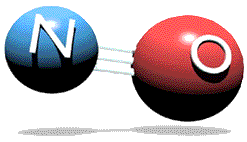A Novel Nitric Oxide Releasing Prostaglandin Analog, NCX 125, Reduces Intraocular Pressure in Rabbit, Dog, and Primate Models of Glaucoma
Abstract
Purpose: Nitric oxide (NO) is involved in a variety of physiological processes including ocular aqueous humor dynamics by targeting mechanisms that are complementary to those of prostaglandins. Here, we have characterized a newly synthesized compound, NCX 125, comprising latanoprost acid and NO-donating moieties.
Methods: NCX 125 was synthesized and tested in vitro for its ability to release functionally active NO and then compared with core latanoprost for its intraocular pressure (IOP)-lowering effects in rabbit, dog, and nonhuman primate models of glaucoma.
 Results: NCX 125 elicited cGMP formation (EC50 = 3.8 ± 1.0 μM) in PC12 cells and exerted NO-dependent iNOS inhibition (IC50 = 55 ± 11 μM) in RAW 264.7 macrophages. NCX 125 lowered IOP to a greater extent compared with equimolar latanoprost in: (a) rabbit model of transient ocular hypertension (0.030% latanoprost, not effective; 0.039% NCX 125, ∆max = −10.6 ± 2.3 mm Hg), (b) ocular hypertensive glaucomatous dogs (0.030% latanoprost, ∆max= −6.7 ± 1.2 mm Hg; 0.039% NCX 125, ∆max = −9.1 ± 3.1 mm Hg), and (c) laser-induced ocular hypertensive non-human primates (0.10% latanoprost, ∆max = −11.9 ± 3.7 mm Hg, 0.13% NCX 125, ∆max = −16.7 ± 2.2 mm Hg). In pharmacokinetic studies, NCX 125 and latanoprost resulted in similar latanoprost-free acid exposure in anterior segment ocular tissues.
Results: NCX 125 elicited cGMP formation (EC50 = 3.8 ± 1.0 μM) in PC12 cells and exerted NO-dependent iNOS inhibition (IC50 = 55 ± 11 μM) in RAW 264.7 macrophages. NCX 125 lowered IOP to a greater extent compared with equimolar latanoprost in: (a) rabbit model of transient ocular hypertension (0.030% latanoprost, not effective; 0.039% NCX 125, ∆max = −10.6 ± 2.3 mm Hg), (b) ocular hypertensive glaucomatous dogs (0.030% latanoprost, ∆max= −6.7 ± 1.2 mm Hg; 0.039% NCX 125, ∆max = −9.1 ± 3.1 mm Hg), and (c) laser-induced ocular hypertensive non-human primates (0.10% latanoprost, ∆max = −11.9 ± 3.7 mm Hg, 0.13% NCX 125, ∆max = −16.7 ± 2.2 mm Hg). In pharmacokinetic studies, NCX 125 and latanoprost resulted in similar latanoprost-free acid exposure in anterior segment ocular tissues.
Conclusions: NCX 125, a compound targeting 2 different mechanisms, is endowed with potent ocular hypotensive effects. This may lead to potential new perspectives in the treatment of patients at risk of glaucoma.

 Results: NCX 125 elicited cGMP formation (EC50 = 3.8 ± 1.0 μM) in PC12 cells and exerted NO-dependent iNOS inhibition (IC50 = 55 ± 11 μM) in RAW 264.7 macrophages. NCX 125 lowered IOP to a greater extent compared with equimolar latanoprost in: (a) rabbit model of transient ocular hypertension (0.030% latanoprost, not effective; 0.039% NCX 125, ∆max = −10.6 ± 2.3 mm Hg), (b) ocular hypertensive glaucomatous dogs (0.030% latanoprost, ∆max= −6.7 ± 1.2 mm Hg; 0.039% NCX 125, ∆max = −9.1 ± 3.1 mm Hg), and (c) laser-induced ocular hypertensive non-human primates (0.10% latanoprost, ∆max = −11.9 ± 3.7 mm Hg, 0.13% NCX 125, ∆max = −16.7 ± 2.2 mm Hg). In pharmacokinetic studies, NCX 125 and latanoprost resulted in similar latanoprost-free acid exposure in anterior segment ocular tissues.
Results: NCX 125 elicited cGMP formation (EC50 = 3.8 ± 1.0 μM) in PC12 cells and exerted NO-dependent iNOS inhibition (IC50 = 55 ± 11 μM) in RAW 264.7 macrophages. NCX 125 lowered IOP to a greater extent compared with equimolar latanoprost in: (a) rabbit model of transient ocular hypertension (0.030% latanoprost, not effective; 0.039% NCX 125, ∆max = −10.6 ± 2.3 mm Hg), (b) ocular hypertensive glaucomatous dogs (0.030% latanoprost, ∆max= −6.7 ± 1.2 mm Hg; 0.039% NCX 125, ∆max = −9.1 ± 3.1 mm Hg), and (c) laser-induced ocular hypertensive non-human primates (0.10% latanoprost, ∆max = −11.9 ± 3.7 mm Hg, 0.13% NCX 125, ∆max = −16.7 ± 2.2 mm Hg). In pharmacokinetic studies, NCX 125 and latanoprost resulted in similar latanoprost-free acid exposure in anterior segment ocular tissues.